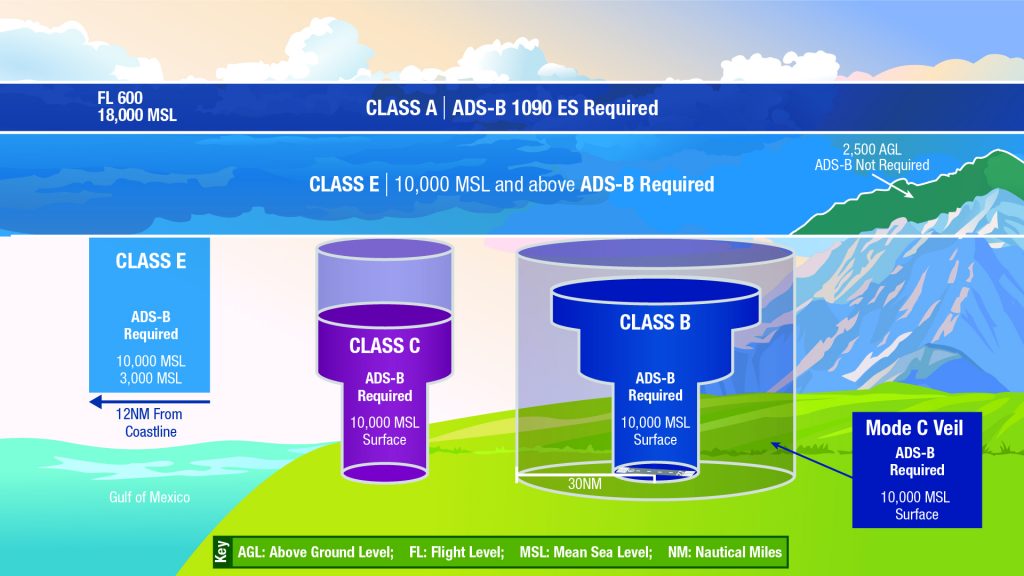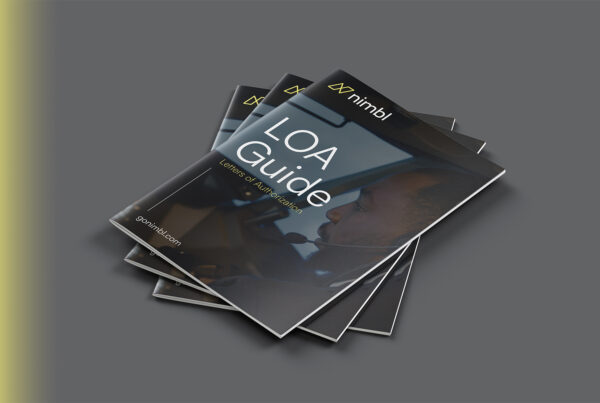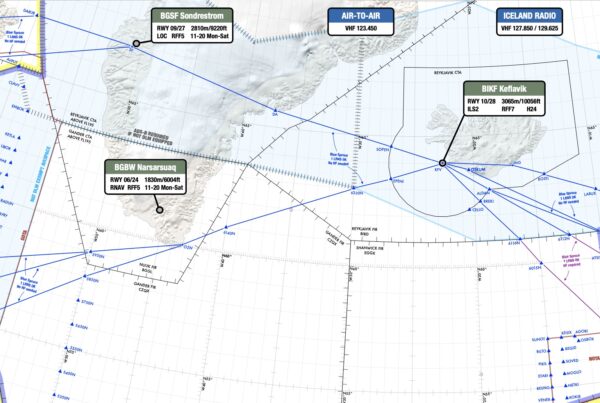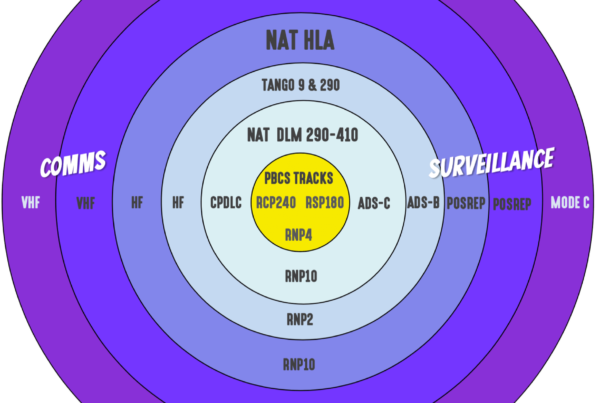ADS-B has come to the US and many parts of the world. What do you need to know?
Firstly, what is ADS-B? Automatic Dependent Surveillance-Broadcast uses the aircraft’s GPS position information and provides it to the mode S transponder allowing ATC to track the aircraft more accurately than radar does.
As of January 1, 2020, all aircraft operating within most US airspace are required to transmit certain information using ADS−B OUT avionics.
Briefly, ADS-B OUT transmits information from the aircraft to ground stations or satellites whereas as ADS-B IN avionics receives information from ground stations or satellite based systems.
The ADS-B required airspace in the US includes everywhere Mode C is required AND:
- Class A, B and C airspace, Class E at or above 10,000’ MSL (but not below 2,500’ AGL).
- Within 30nm of Class B (Mode C veil).
- Above the ceiling and within lateral boundaries of Class B and C up to 10,000’.
- Class E over Gulf of Mexico, at and above 3000’ MSL within 12 nm of US coast. The non-contiguous US is also included: Hawaii, Guam, Puerto Rico and Alaska.
 Also, according to the US AIM, operators flying at 18,000 feet and above will require equipment which uses 1090 ES (extended squitter). Those that do not fly above 18,000 may use either UAT (Universal Access Transceiver) or 1090ES equipment. For international operations 1090ES is by far the most accepted system.
Also, according to the US AIM, operators flying at 18,000 feet and above will require equipment which uses 1090 ES (extended squitter). Those that do not fly above 18,000 may use either UAT (Universal Access Transceiver) or 1090ES equipment. For international operations 1090ES is by far the most accepted system.
Here’s the operational stuff…
For the most part you may notice very little change from radar controlled airspace and there may be no ADS-B specific controls in your cockpit.
During flight you may encounter ADS-B specific phraseology. Instead of the word ‘radar’ you may hear ‘surveillance’ as in ‘Surveillance service is terminated’. Another example would be ‘Pressure altitude is invalid’ instead of the previous ‘Mode Charlie is invalid’.
Failures may be dealt with differently depending upon avionics installations so check your manuals for any specific procedures. One example is if your left side GPS fails and you are using your number 1 transponder then ADS-B may loose data input therefore select transponder number 2 to continue ADS-B data transmission. There may be no indication of the ADS-B failure in the cockpit.
In the US, the operator is required to fly a route that has ADS-B service availability so the FAA has provided an ADS-B Service Availability Prediction Tool (SAPT) which should be used not more than 24 hours prior to the planned departure to ensure the planned route has ADS-B coverage. If there is an ADS-B outage along your planned route you must plan another route. Make sure your flight planning provider is doing this!
Flight planning codes are important as this is the only way that ATC knows you are properly equipped and authorized. The FAA’s InFO 15015 has good information on filing correctly. There are numerous codes for ADS-B equipment based on your specific installation of 1090MHz ES, UAT and/or VDL mode 4.
The FAA encourages the reporting of ADS-B surveillance malfunctions (AIM 4-5-7 f.). You can do this by phone or radio to the nearest Flight Service Station.
What if I don’t have ADS-B installed right now?
If you still don’t have ADS-B, your options aren’t great. The FAA spells it out in the Federal Register, but simply put, you must receive authorization from ATC to fly before every flight that is planned in ADS-B required airspace.
To do that, you have to use the new ADS-B Deviation Authorization Preflight Tool (ADAPT) that the FAA has developed – which allows you to request authorisation to fly from ATC. Do this online, at least one hour but not more than 24 hours before your flight. AOPA give this advice: “Don’t call the ATC facility to ask, and don’t request access from a controller over the radio – the answer will be no. Only if your ADS-B Out hardware fails in flight will controllers be able to issue an airspace authorization to an airborne aircraft.”
The word from the NBAA is that there is no planned relaxation of the ADS-B rules, so operators who have not equipped will be at the mercy of ATC for every single flight planned through ADS-B airspace. ATC might not be able to grant authorizations for a variety of reasons, including workload, runway configurations, air traffic flows, and weather conditions.
What are the ADS-B rules in the rest of the world?
ADS-B usage is expanding in many countries at different rates. We have compiled a list below of countries and requirements.
Mandates now in effect…
Australia: Requires ADS-B for operations at or above Flight Level 290. Foreign aircraft can operate without ADS-B below FL290 until June 2020. Check AC 21-45 for more info.
Hong Kong: The AIP GEN 1.5.3 states: All aircraft flying within Hong Kong FIR at or above F290 shall be installed with ADS-B. This requirement has been in place since December 2014!
Taiwan: In Jan 2020, ADS-B became mandatory for all aircraft operating within the Taipei FIR, at or above FL 290. Check our article for more info.
Vietnam: Since July 2018, Vietnam has required aircraft over MTOW 15,000kg to have ADS-B. But from 1st Jan 2020, this limit was brought down to apply to all aircraft over 5,700kg. Aircraft without ADS-B can still operate through Vietnam’s airspace, but are restricted to the lower levels. AIC 08/16 has all the details.
India: The ADS-B mandate across Indian airspace outlined in AIP SUP 148/2018 was due to take effect on 1st Jan 2019, has got delayed to 1st Jan 2020 (as advised by Notam). This AIP supplement states that all aircraft flying on PBN Routes pretty much everywhere in Indian continental airspace at or above FL290 must carry serviceable 1090 MHz ES ADS-B transmitting equipment that has been certified as meeting the requirements.
United Arab Emirates: AIC 13/2019 published in Nov 2019 says “Operators are made aware that ADS-B OUT will be mandated from 01 January 2020 within UAE airspace.” That means you need ADS-B everywhere, at all flight levels!
Malaysia: As per AIC 03/2017, from 31 December 2019 you need ADS-B to be able to operate on airways N571, P628, L510, P627, L645 and P574 between FL 290 to FL 410.
Singapore: Since May 2018, ADS-B has been required for ops at or above FL290 on airways L642, L644, M753, M771, M904, N891, N892, Q801, Q802, Q803 and T611. Check the AIP ENR 1.8 Section 7 for details.
Indonesia: Since the start of Jan 2018, all aircraft flying in Indonesian airspace at or above FL290 needed to be equipped with ADS-B. Check our article for more info.
French Polynesia/Tahiti: The AIC PAC-P A 06/19 says that from 1 January 2019, aircraft flying above flight level 195 need ADS-B. Then from 1 January 2022, this will be required for all flight levels!
Upcoming mandates…
Europe: ADS-B will be required after 7 June 2020 for aircraft over 5700kg and flying faster than 250 knots and on an IFR flight plan. There will be some exemptions for older aircraft in Europe. Check this EASA doc for more info.
Seychelles: From 7 June 2020, you’ll need ADS-B to fly through the FSSS/Seychelles FIR. AIC 1/2019 applies.
New Zealand: The CAA proposed rule change would make ADS-B mandatory for all aircraft in controlled airspace below Flight Level 245 from 31 Dec 2021.
Saudi Arabia: ADS-B will be required in Class A and B airspace starting 1 Jan 2021. The way they’ve published this is confusing: the requirements are laid out in this GACAR Part 91 document, backed up by this Notam issued for the OEJD/Jeddah FIR:
A1871/19 – ADS-B OUT REQUIREMENT ENFORCEMENT DATE IN CLASS A AND B AIRSPACE AS PER GACAR PART 91.303 IN KINGDOM OF SAUDI ARABIA HAD BEEN CHANGED TO 1 JANUARY 2021 INSTEAD OF 1 JANUARY 2020. 31 DEC 19:15 2019 UNTIL PERM. CREATED: 31 DEC 19:30 2019
Mongolia: This one straight from the AIP SUP: From 17 June 2021 at 0000 UTC, all aircraft flying within the airspace of Mongolia above flight level 6150m must carry serviceable ADS-B transmitting equipment (Mode S Transponder and GNSS source position)… Whilst aircraft flying below flight level 6150m, the carriage of ADS-B equipment remain optional.
Mexico: A Circular issued by the Mexican CAA in Dec 2019 advises that the ADS-B requirement over airspace of Mexico has been delayed until 1 Jan 2022.
South Africa: The plan was to mandate ADS-B at or above FL290 from April 2020, but they have recently issued a draft AIC that says this will be delayed to 15 June 2023.
Canada: In Nov 2019, Nav Canada announced it was delaying its 2021 ADS-B mandate. No new date has been set yet. So although ADS-B will be used for surveillance in Class A airspace (i.e. above FL180) from 25 Feb 2021 onwards, it won’t be mandatory for aircraft to be equipped.
Sri Lanka: Not mandated yet, but something’s in the pipeline. The CAA states on their website: “This is to inform all aircraft operators operating in Sri Lanka airspace (Colombo FIR) that ADS-B trial operations have been commenced and in the near future it will be fully operational covering the entire Sri Lanka sovereign airspace and extending the surveillance coverage of Colombo FIR further.”
Any countries we missed? Let us know!
More on the topic:
- More: ADS-B Controversy? Landing Fee Fuss in Florida
- More: US FAA: Swift Move to Improve Flight Tracking Privacy
- More: Canada Mandates ADS-B in Class A Airspace
- More: ADS-B Mandates in 2023
- More: Cloaking Devices: The ADS-B Privacy Issue
More reading:
- Latest: LOA Guide for US Operators
- Latest: NAT Ops: Flying the Blue Spruce Routes
- Latest: NAT Guide 2025 – My First NAT Flight is Tomorrow
- Safe Airspace: Risk Database
- Weekly Ops Bulletin: Subscribe
- Membership plans: Why join OPSGROUP?










 Get the famous weekly
Get the famous weekly 






We had to ferry a C550 without ADS-B equipment to Florida. Used the ADS-B Deviation Authorization Preflight Tool (ADAPT) – so far no problem.
Used the ADAPT tool which is quite easy to use. Got the approval by email within seconds. Never got questionned about during flight.